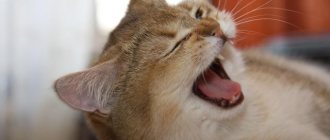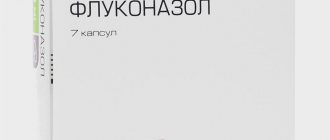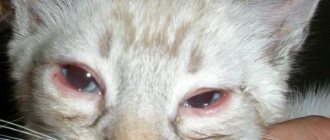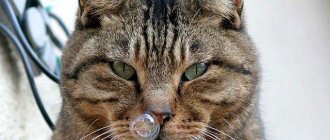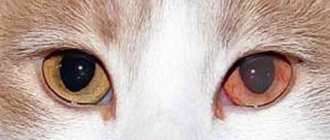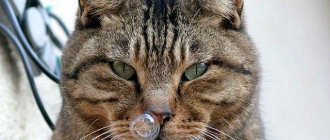12104Pavel
7
Cats are the cleanest pets, washing themselves thoroughly after each awakening. They lick the fur and use their paws to “remove” dried brownish crusts from the corners of their eyes. Usually the owner does not notice such formations, but when a cat’s eyes fester, discharge from them and souring become constant and clearly visible. This symptom is considered dangerous and should be eliminated under the supervision of a veterinarian. Why does such a pathology develop, what to do, what should be used to treat a pet whose eyes are festering? Find out the answers to these questions by reading the article.
Causes of pus in the eyes of cats
All causes of eye suppuration in cats can be divided into several large groups:
- Mechanical damage to the retina. Accompanied by temporary inflammation followed by watery discharge. The latter accumulate in the inner corners of the eye in the form of small, hard brown or black lumps.
- Chemical exposure that causes an animal to develop blepharitis (inflammation of the edges of the eyelids).
- Colds or allergies are often accompanied by clear or white mucous discharge from the nose and eyes.
- The body's response to the action of pathogenic microorganisms. The discharge is yellowish-green in color and is recognized by the specific smell of pus.
- The result of a complication of conjunctivitis that occurs when a veterinarian is not consulted in a timely manner.
- Helminthiasis. In addition to the main parasitic factor, helminths poison the animal’s body with the products of their vital activity. As a result, an allergic reaction occurs, accompanied by mucus from the nose and suppuration of the eyes.
We recommend reading the article about eye diseases in cats to understand the topic in more detail.
Treatment, prognosis
There is no single treatment for purulent eyes in a cat. The veterinarian develops an individual regimen depending on the disease, with the elimination of which the problem of purulent discharge will disappear.
Eye drops and ointments are required, which are divided into three groups:
- Antiseptic (bactericidal). The composition includes polysept, anesthesin and other components that help eliminate pain. The most effective are drugs such as Oftalmosan, Lakrikan.
- Antibacterial. Indicated for bacterial infections. Tsiprovet, Dekta-2, Lacrimin aseptic have proven themselves well. They relieve inflammation and successfully treat chronic diseases of the organs of vision.
- Immunomodulatory. Prescribed for inflammatory processes and viral infections. As a rule, the veterinarian prescribes Anandin and Maxidin. They strengthen the immune system, accelerate wound healing and suppress the activity of viruses.
The medicine and dosage are determined by the veterinarian. Before applying ointment or instilling drops, the eyes must be cleaned of pus and crusts using a special disinfectant solution.
Congenital anomalies are corrected surgically.
Symptoms
An experienced owner always pays attention to the behavior of his pet. Symptoms:
- Loss of appetite, general lethargy, increased sleep duration.
- Increased body temperature.
- Preference for dark, secluded places due to increased sensitivity to light.
- Squinting or closing your eyes most of the time.
- The presence of a specific odor.
- The appearance of a rare cough, redness of the mucous membrane, runny nose.
Symptoms of a pet's disease
When a pet gets sick, accompanying symptoms immediately appear. If the owner notices one or more of the following signs of disease in the kitten, he needs to urgently contact a veterinarian.
- The pet has become aggressive and angry, very often rubbing its eyes with its paw:
- The kitten refuses to eat and sleeps poorly;
- In the light, the pet closes its eyes and tries to stay in a dark corner;
- Increased body temperature;
- The eyes water, become red, and purulent formations flow out of them;
- The fur takes on a brownish tint after about a century.
Diagnostics
If primary suppuration occurs, the owner should immediately contact a qualified specialist, preferably a specialist, an ophthalmologist. Time and strict adherence to the doctor’s instructions play an important role in the favorable outcome of treatment.
You should take eye diseases in newborn kittens especially seriously, because... complications later will pose an even greater danger.
Without laboratory tests and an integrated approach, it is impossible to be sure that the diagnosis is correct. Unfortunately, not all owners remember this, preferring self-medication at home to an experienced veterinarian.
The kitten's eyes are festering: reviews
Please note that in order to choose the right treatment, you need to consult a doctor and read the reviews. Please note that an incorrectly selected remedy may not only not improve the condition, but also cause complications.
The kitten's eyes are festering, reviews:
Oksana. We have an ordinary yard kitten that we picked up from the street. After they brought it home, they discovered that the kitten had terrible sour eyes. We did not go to the veterinarian, we used Furacilin for washing, and smeared it with Tetracycline ointment. After about 2 weeks, the kitten completely recovered.
Maria. Our cat's eyes began to turn sour after a walk outside. Perhaps she caught an infection. We contacted the veterinarian and were prescribed Chlorhexidine rinsing and Floxal ointment. It turned out to be very effective, after about 7 days the eyes stopped turning sour, but we extended the treatment to 2 weeks.
Alexander. Kittens were born in our yard, but the cat does not live in the house, but lives on the street. After the babies opened their eyes, they became very sour. I felt sorry for the kittens, so I periodically rubbed my eyes with strong black tea and dripped cheap drops of Albucid. I myself know that these drops sting, but are effective. After a week, the cats’ health improved and their eyes stopped turning sour.
Sore eye
As you can see, sour eyes in cats is a common problem that can be caused by an allergy to food or injury. With timely diagnosis and treatment, the disease can be completely defeated.
Treatment methods
It is important to remember that the success of recovery directly depends on the accuracy of the diagnosis and the person’s willingness to fully comply with the instructions.
Recommendations:
- For a complete diagnosis, the doctor requires an anamnesis, i.e. information about the cat: what conditions the pet lives in, its diet, previous diseases, behavioral characteristics, proximity to other animals.
- It is advisable to wash your cat’s eyes with a warm chamomile solution before visiting the veterinary clinic.
- Depending on the causes of suppuration, the doctor may use several treatment approaches. In case of prolonged and profuse discharge from the eyes and nose, as a rule, a novocaine blockade with the administration of an antibiotic is prescribed. If discharge from the eyes is the result of mechanical damage, use Levomycetin drops for an adult cat or Albucid for one-month-old kittens.
What does purulent discharge from a cat's eyes look like?
The purulent discharge from the eyes of a cat is opaque in appearance, has a viscous consistency, and has a yellowish or greenish color, which determines the appearance of the microflora that caused the formation of pus. Depending on the amount of discharge, it can be in the corners of the cat’s eyes, form streaks on his face and dry yellowish crusts, and also form cloudy filmy deposits on the conjunctiva.
The appearance of the eye changes, the most common are:
- redness of the conjunctiva and eyelids;
- swelling of the conjunctiva and eyelids;
- prolapse of the third eyelid on the affected eye;
- blepharospasm - narrowing of the palpebral fissure caused by protective contraction of the eye muscles;
- photophobia - the cat squints the affected eye when in the light, trying to find dark places.
The animal's behavior changes:
- the cat scratches its eyes with its paws and rubs its muzzle against surrounding objects;
- blinks frequently;
- sneezes rarely if this is due to part of the discharge entering the nasal cavity through the nasolacrimal duct, and often if purulent discharge from the eyes is associated with the development of an infectious disease;
- tries to hide in dark places;
- the cat is apathetic, does not want to play, and his appetite decreases.
Purulent discharge is opaque, viscous consistency, with a yellowish or greenish tint
List of recommended drugs
Based on the causes of the disease, the veterinarian most often prescribes the following medications:
- For bruises and injuries - drops of Levomycetin or Iris.
- For swelling - a solution of hydrocortisone and novocaine.
- For acute illness - intramuscular antibiotics.
Prescribing medications for an animal should only be done by a professional after a complete diagnosis. Self-treatment without the guidance of a veterinarian can lead to complications and irreversible pathologies.
What to do and how to treat?
Before visiting the doctor, you can wipe your pet’s eyes with a herbal decoction.
If the owners notice that the cat’s eyes are festering and other alarming symptoms are recorded, then they should not delay a visit to the veterinarian. At home, it is possible to treat the visual organs with decoctions based on chamomile, calendula and other medicinal herbs that have antimicrobial and antiseptic effects. After conducting a comprehensive examination and identifying the root cause of the problem, the pet is prescribed medications.
You should not apply any eye drops to cats for pus at your own discretion, since there is a high probability of worsening the disease and developing complications. In most cases, it is possible to cope with unpleasant symptoms in a pet with the help of the following ophthalmic medications:
- "Iris";
- "Leopard";
- "Diamond Eyes";
- "Levomycetin".
For a speedy recovery of your pet and elimination of pathological exudate, you need to know how to properly apply eye drops to a cat. To do this, the pet's head is fixed so that the visual organs are directed upward. It is better to perform the manipulation together to ensure reliable fixation of the cat. The pipette must be kept at a distance of 2 centimeters from the eye, so that in case of sudden movement it does not damage the mucous membrane of the eye. Treatment is carried out until the animal recovers completely, until the discharge completely stops appearing.
Tips for beginners when washing eyes
Eye washing is one of the most important points in the treatment and prevention of disease in any animal.
You can do the procedure yourself at home or go to a veterinary clinic. During a period of illness, a cat is most often reluctant to allow its owner to approach it.
Representatives of the Persian, British and Siamese breeds are especially capricious. In this situation, it is advisable to ask a family member to hold the cat's head during the procedure. It is best to secure it with a towel or diaper.
Recommendations:
- A folded cotton pad or a tight tourniquet is suitable for rinsing. It is better to avoid cotton swabs, as they do not absorb liquid well, have a relatively small surface and can damage the retina when the animal tries to escape.
- For sterility purposes, it is better to prepare separate dishes for washing each eye. For the same reason, you should use a cotton pad no more than once.
- It is not recommended to touch the inflamed surface with a dry disc.
- Hands must be washed.
- All solutions must be at room temperature.
- Keep in mind that a swollen area can often cause pain for your cat.
- The best treatment is comprehensive. After rinsing with the solution/drops, re-treat the inflamed area with ointment.
- You need to repeat washing as often as possible. Step-by-step instructions for washing eyes
- Fix the animal on its side, turning its head up, holding the chin.
- If a crust forms and the eye sticks together, soften the inflamed area with Vaseline oil. Using cotton wool soaked in 3% hydrogen peroxide, remove the discharge, then rinse with the solution and apply eye drops.
- Apply the solution to the eyeball, gently lifting the eyelids.
- Raise and lower the animal's eyelids several times to distribute the medication evenly. Remove excess with a disc.
- Do not forget about nasal discharge, remove it with a cotton pad.
What diseases can cause your eyes to fester?
Purulent discharge from the eyes is a symptom of both eye diseases and general diseases.
Common diseases accompanied by purulent discharge from the eyes
Common diseases that cause cat eyes to fester:
- Allergy - at the beginning of the disease, the discharge is mucous in nature, bilateral in nature, which changes to purulent with the addition of secondary microbial flora. Additionally observed: sneezing;
- nasal discharge;
- redness of the conjunctiva;
- skin rash.
- instability of appetite;
- panleukopenia: sudden fever up to 40–41 ° C;
- fever;
- fever;
- periodic fever;
- at the very beginning of the disease, the purulent discharge is unilateral, later the second eye is affected;
Chemosis is the predominant symptom when the conjunctiva is affected by chlamydia
- fever;
- sneezing, coughing;
Photo gallery: systemic diseases in which purulent discharge from the eyes is observed
Panleukopenia causes profuse purulent discharge from the eyes and nose.
With herpetic conjunctivitis, the discharge from the eyes is purulent in nature
With chlamydia, purulent discharge from the eyes is typical, as well as chemosis - swelling of the conjunctiva
Measures to improve the condition of the conjunctiva
In case of general diseases, purulent discharge from the eyes is treated only together with the underlying pathology of which they are a symptom. To improve the condition of the eyes in case of general diseases, the following are used as part of complex therapy:
- Regular toilet of the eyes to remove pus and microbial accumulations using hygienic eye lotions: Klini;
- Veda;
- Dewdrop.
- Tsiprovet;
- tetracycline ophthalmic;
- Forvet;
Anandin is a drug that has anti-inflammatory, antiviral and immunomodulatory effects.
Table: eye diseases with purulent discharge
| Type of disease | Symptoms | Treatment |
| Eye injury |
|
|
| Conjunctivitis is an inflammation of the conjunctiva and eyelids, which is unilateral or bilateral. |
|
|
| Keratitis - inflammation of the cornea |
|
|
| Blepharitis - inflammation of the eyelids |
|
|
| Uveitis - inflammation of the choroid of the eye |
|
|
| Entropion is a chronic injury to the surface of the eye by the edge of the deformed eyelid, as well as by its eyelashes. |
| Surgical restoration of the correct position of the eyelid |
| Dacryocystitis - inflammation of the lacrimal sac |
|
|
Thus, purulent discharge from a cat’s eyes may indicate both the presence of a systemic disease and the development of eye disease. Moreover, purulent inflammation can mask the primary nature of the process and return after the use of antibiotics without treating the underlying cause of the disease.
Photo gallery: eye diseases that cause purulent discharge from the eyes
Purulent discharge from the eyes in cats most often occurs due to conjunctivitis.
Keratitis is characterized by clouding of the cornea. Dacryocystitis is characterized by swelling at the inner corner of the eye.
Entropion of the eyelid is treated surgically
Table: drugs that are used to treat eyes in cats with purulent discharge
| A drug | Compound | Operating principle | Application | Price, rubles |
| Ophthalmosan, eye drops |
| Bactericidal, anti-inflammatory, decongestant |
| 185 |
| Leopard, eye drops |
| Antibacterial agent |
Instill 1-2 drops 3-4 times a day for a course of 1-2 weeks. | 159 |
| Ciprovet, eye drops | Ciprofloxacin | Antibacterial agent |
Instill 1 drop 4 times a day for 1–2 weeks. | 196 |
| Tetracycline eye ointment | Tetracycline | Antibacterial agent | Infectious eye diseases caused by pathogens sensitive to tetracycline. Apply 3–5 times a day. | from 44 |
| Maksidin 0.15, eye drops | Germanium bis(pyridine-2,6-dicarboxylate) |
| Treatment of conjunctivitis and keratoconjunctivitis. Apply 1 drop 2-3 times a day for a course of no more than 2 weeks. | 52 per bottle |
Photo gallery for the treatment of eye diseases with purulent discharge
Sinulox is used for systemic antibacterial therapy for infectious eye diseases.
Tetracycline ointment has a broad spectrum of action and is used to treat both bacterial conjunctivitis and chlamydia
Bars eye drops are a combined antibacterial drug with an extended spectrum of action.
Korneregel promotes corneal healing
Maxidin is a veterinary drug that is used for immunocorrection in the fight against diseases of viral origin.
Dekta-2 eye drops are intended for the treatment and prevention of ophthalmic diseases of bacterial origin in pets
Ciprovet for cats is an effective antibacterial drug with a complex spectrum of action.
How to treat a cat's eyes
To carry out treatment procedures, it is better to use the help of an assistant who would hold the cat. If there is no assistant, the cat is immobilized, swaddled in a towel.
The following treatment procedures are carried out at home:
- Eye rinsing: a napkin is moistened with eye lotion or an antiseptic solution and passed over closed eyelids, removing secretions;
- if the eyelids are stuck together, a napkin richly moistened with an antiseptic solution is applied to them and lightly pressed, after which the eye will open, you cannot use force to open the eye, you can damage the eyelids;
- You cannot touch the surface of the eye with a napkin; it is washed with an antiseptic solution from a syringe, after removing the needle.
Since ointments and drops are irritating, it makes sense to wear a protective (Elizabethan) collar on the cat to prevent scratching of the eyes with its paws.
Protective collar prevents paws from scratching your eyes
Video: how to care for your pet's eyes
Types of tinctures and solutions
Eye solution can be purchased at a pharmacy or prepared independently.
The most effective are:
- Camomile tea. Dilute one tablespoon of dried flowers in a glass of boiling water. Leave for 30 minutes.
- A decoction of strong tea. It is advisable to use whole leaves and distilled water.
- Table salt solution. For a liter of distilled water, take 1/2 teaspoon of salt. The mixture is brought to a boil. Not suitable in case of an allergic reaction.
- Lacrimin or Medkinos solutions, which can always be purchased at a pharmacy at an affordable price.
The kitten's eyes are festering - what should I wash it with?
To wipe the eyes, you can use not only decoctions of medicinal herbs, but also pharmaceutical preparations, which are widely used in surgery and in the treatment of wounds of various origins.
The kitten's eyes are festering, what to wash with:
- Furacilin solution. To prepare the product, you need to dissolve two tablets in 250 ml of hot water and heat almost to a boil, with constant stirring. It is necessary that the tablets dissolve completely. Cool the product to room temperature, soak a cotton pad in it, and wipe the cat’s eyes.
- Potassium permanganate solution. Please note that the liquid should be slightly pink, meaning the solution should be weak. Under no circumstances should a strong solution be used, as it can cause burns to the mucous membrane. A couple of crystals per glass of warm boiled water is enough. In the same way, you need to soak a cotton pad in the resulting solution and wipe your eyes.
- To treat the eyes, you can use ready-made solutions. Among them are Chlorhexidine, Miramistin, Decasan . These solutions are created without the use of alcohol, so they do not cause burns to the mucous membranes or discomfort during treatment. Ready-made products can be purchased at the pharmacy. Choose a solution that is suitable for treating mucous membranes. For example, for Chlorhexidine this is a 0.05% solution. It is necessary to soak a piece of gauze with the product and wipe the kitten’s eyelids from the outer corner of the eye to the inner one. Treatment with such antiseptics is carried out 3 times a day. This removes suppuration and also reduces the kitten's anxiety. After all, suppuration and dry crusts cause discomfort and unpleasant sensations in the animal, so the cat can additionally infect the wound.
Rest
Choosing eye drops
Unlike infusions, it is impossible to prepare drops at home. You can find the necessary remedy at a veterinary or regular pharmacy.
It is important to remember that neither solutions nor drops can provide a 100% healing effect. The latter are necessary only to slow down the development of the disease.
The most commonly prescribed drugs are:
- Sulfacetamide.
- Levomycetin drops.
- Diamond eyes.
Cosmetic defect
Brown discharge from the corners of the eyes in cats is not always a sign of pathology. The cornea is constantly washed by tear fluid, but under certain circumstances it becomes larger.
The amount of discharge increases in strong winds, due to bright light, if the cat is in a dusty or smoky room.
The tear fluid contains substances that, when exposed to ultraviolet radiation, acquire a brownish tint. Dark discharge is most noticeable in the following cats:
- with light coat color;
- with a flattened muzzle;
- in older individuals;
- in emotional pets - when they purr, they produce copious amounts of tears or saliva.
Minor discharge, which over time turns into dried brown crusts, is not a pathology and does not threaten the cat in any way. This is just a cosmetic defect. Brown marks are usually removed using daily hygiene products.
Attention! You should not wipe your cat's eyes with hydrogen peroxide. If it comes into contact with the mucous membrane, the solution may cause irritation and discomfort.
Selection of ointments and method of their use
For best effect, it is recommended to use ointments. As a rule, tetracycline ointment (1%) is used.
Apply it as follows:
- First, purulent discharge from the eyes and nose is removed. Gently wash the inflamed areas with a cotton pad soaked in tincture or solution.
- To enhance the effect, the ointment is warmed to room temperature in advance.
- Lightly pull back the cat's lower eyelid, apply ointment to its inner surface, placing the latter with a special spatula.
- The eyelids are closed, massaging in a circular motion to better distribute the ointment over the surface of the swollen eye.
- Remove excess with a cotton pad.
How are cat eyes treated?
At the first alarming symptoms, the cat should be taken to the veterinarian. Complex treatment is prescribed only by a specialist after appropriate tests and diagnostic studies. Self-medication can sometimes lead to sad and sometimes even fatal consequences. But still, you will be able to provide first aid to your pet, and in the future you will be able to independently carry out the procedures prescribed by the veterinarian, so as not to take the animal to the clinic every time for procedures. If the disease is acute, intensive therapy can only be carried out in a hospital setting. Next, we will consider what treatment methods are used for purulent discharge.
Washing a cat's eyes
This method can be used as first aid for a sick pet. How to wipe and wash a cat's eyes:
- chamomile or St. John's wort solution;
- 0.02% furatsilin solution or solution 2 tab. furatsilin per 1 tbsp. water;
- boric acid solution: 2 teaspoons per 500 ml of warm boiled water.
It is better to carry out the procedure together or secure the cat by swaddling it with a sheet or diaper. Rinsing is carried out with a clean cotton pad, which is twisted into a tourniquet, dipped into the solution and squeezed into the eye. Dried crusts are carefully removed.
Putting drops into a cat's eyes
What is allowed to instill:
- drops with antibiotic and dexamethasone: Tobrazon, Levomycentin drops;
- antiviral drops: Actipol, Okoferon;
- Neoconjunctivitis drops;
- "Diamond Eyes";
- Albucid;
- Iris.
Floxal drops, used in the treatment of human eyes, have proven themselves well. Veterinarians note that human drops are suitable for cats, but only with the prescription of a veterinarian.
Eye drops are instilled into a cat after first immobilizing the animal and placing it on its side, swaddled or with the help of an assistant. At the same time, the head is raised and held with the muzzle up. Drops are pipetted onto the conjunctiva and cornea of the open eye.
Remember: drops will not help cure the underlying disease and are not a panacea, but they will help eliminate the acute symptoms of purulent eyes.
Placing medicinal ointment under the eyelid
After washing and instilling drops under the lower eyelid, it is recommended to put a medicinal ointment. For this, tetracycline ointment 1% is used. The lower eyelid is pulled back, the ointment is placed there with a spatula, after which the eyelid needs to be closed and massaged a little for better distribution of the medicine. It is recommended to preheat the tube of ointment.
A training video from a veterinarian on how to put ointment under a cat’s eyelid.
How to treat an eye injury
If a cat's eye is red, purulent and swollen, the pet most likely has an injury. It is unacceptable to treat the eyelids with brilliant green or iodine: this can cause a painful shock and provoke pathological changes in the eye. Even if you see that a thorn is stuck in an animal’s eye, do not rush to pull it out yourself. It is best to take the animal to the clinic: you cannot know how deeply the foreign body has entered the eye area and damaged the cornea.
Preventive measures necessary to avoid eye diseases
Vaccinations and periodic deworming are universal ways to protect any animal. It is also important to consider the breed of the cat.
Some of them, such as the Sphynx, require increased attention to the skin. Having no fur, they are more susceptible to suppuration. Not only do they require daily care and eye washing, but they also need to repeatedly wipe their ears with a warm solution.
The opposite situation is the Persian breed with thick hair. In case of suppuration, snot and other mucous secretions, you should cut off the hair around the swollen organ and, after recovery, carefully ensure that the hair does not fall into the area of the former inflammation.
If infected, you should not allow the infectious animal to come into contact with your child or healthy pets; it is also important to remember your own safety measures when treating your eyes.
If the cause of eye discharge is an injury, then it is better to make an appointment with a veterinarian, undergo a full course of treatment, and also see a doctor regularly after that (preferably every month).
Daily animal care is the key to health. As a rule, it is difficult to train an adult cat to wash its eyes. However, for some breeds such safety measures are simply necessary due to their anatomical features, for example, Scottish Folds. Therefore, it is better to accustom your cat to such procedures from the first weeks of life.
When and why is rinsing necessary?
Animals are not always able to remove accumulated discharge from the outer and inner corners of the eyes. Therefore, the owner needs to periodically help the pet with hygiene. In other cases, rinsing becomes one of the methods of therapy when it is necessary to cure an eye disease.
Causes and symptoms of eye diseases
There is no need to panic if your pet’s eyes begin to water - perhaps a speck of dust has landed on the cornea, and the body has activated a protective reaction in the form of profuse lacrimation. Such conditions quickly, within one day, cease without human help. But there are also more serious cases - eye damage or diseases:
- Scratches and wounds
. A pet can get eye injuries during a fight, play, or fall. Symptoms include redness, swelling, and in rare cases, bleeding.
- Foreign body entry
. Accompanied by severe lacrimation, redness of the eyelid and cornea; if the speck remains in the eye for a long time, pus may appear.
- Inflammation of the eyelids, or blepharitis
. With ordinary inflammation, the cat begins to scratch its eyes, as a result of which the eyelids turn red. With phlegmous inflammation, the eyelid swells and cloudy mucus oozes from the eye. Blepharitis often occurs after severe scratching and wounds, that is, it is a secondary infection.
- Entropion and eversion of the eyelid
. Abnormal position of the eyelid occurs when a foreign body enters, when exposed to strong chemicals, or from burns. This can lead to conjunctivitis or keratitis (inflammation of the cornea). Symptoms: lacrimation, photophobia, redness of the conjunctiva.
- Parasitosis
. Some types of helminths settle in unexpected parts of the body, including the eye area.
- Infections
– one of the most dangerous conditions. The outbreak can be concentrated only in the eye (viral conjunctivitis) or affect the entire body (distemper, chlamydia, etc.). The infection is characterized by swelling and narrowing of the eyes, copious discharge with pus, crusting and sticking of the eyelids.
- Allergy
– like a person, a cat’s eyes can become watery due to an allergy to pollen, citrus particles, perfume, etc. In this case, redness of the eyelids and strong transparent discharge are observed.
There are breeds of cats in which eye problems occur more often due to anatomical features: these are British, Rex, Sphynx. They require more careful care.
To avoid or prevent illness, it is necessary to periodically check your cat's eyes - every day, as soon as you pick up your pet, briefly examine its face. Do not forget to carefully remove accumulated dirt and vaccinate once a year.
Indications for eye rinsing
Sometimes an animal is not able to wash itself thoroughly: due to young or old age, illness, too long hair on the face and other reasons. Then it is recommended to pay attention to this once every 1-2 days - for hygiene purposes.
More frequent rinsing is needed if the pet becomes ill. Simple strong tea will not help here - you need medicines, drops and ointments. Only a veterinarian will tell you the procedure for their use after examination and making an accurate diagnosis.
Precautions
In case of severe illnesses, you should not self-medicate without the advice of a veterinarian. This can lead to serious complications, including loss of the eye. Therapy must be agreed upon with a specialist, who will also calculate the dosage and course of drug use.
If everything is not so serious and the cat needs a banal cleansing, you can carry out the procedure yourself several times until the condition improves. Remember the contraindications and precautions:
- do not rinse your eyes with plain water - it destroys the natural microflora and dries out;
- do not use cotton wool - its fibers can damage the cornea or get under the eyelid, so take cotton pads or a gauze swab;
- each eye should have its own disc or tampon to avoid spreading infection from one eye to the other;
- Do not wash your cat's eyes with chamomile infusion, as this often leads to baldness of the eyelids.
Always follow through with treatment. If after two days of washing the furry patient’s condition has not improved, contact your veterinarian.
Street cats
The reason for the prevalence of eye diseases among street cats is the lack of normal living conditions. Frequent fights, lack of medication, constant contact with other animals, poor diet, temperature changes and other factors cannot have a beneficial effect on recovery. As a rule, environmental conditions only aggravate the situation and lead to serious consequences.
Adopting a stray cat is easy. However, one should always be aware of the level of responsibility that a person takes on with such a decision.
In most cases, street cat diseases are in late stages, so the treatment period can take a long time and cost a lot of money.
At the same time, homeless animals are the most loyal creatures in the world, unlike many purebred animals. Such a cat will be grateful to its owner and can become his best friend.
1111
The kitten has snot and festering eyes - reasons: how to treat?
Calcivirus (calcivirosis) is a dangerous viral disease that affects approximately 30% of cats. It is not necessary that the cat be an outdoor cat. The virus can often be carried on clothing or on unwashed hands. The virus can survive on clothes and shoes for about one to two weeks without being introduced into the animal’s body. Therefore, the owner can bring illness from the street. Calcivirus is not dangerous for people, but about a third of cats die from this viral disease and the complications it causes.
Calcivirosis is manifested by the following symptoms:
- Runny nose and sneezing for one to two days.
- Heavy discharge from the eyes. They appear around the third day. The cat's appetite worsens, it may refuse to eat, and its body temperature rises.
- Around the seventh day, small ulcers and stomatitis may appear in the mouth.
The kitten has snot and festering eyes, how to treat:
- Treatment of calcivirosis is antiviral. The animal is given immunomodulators, and concomitant infections that are caused by weakening of the body as a result of exposure to the virus are also treated.
- Very often, cats die from bacterial complications that arise from the virus. Among them are pneumonia, arthritis, arthrosis, dehydration, and kidney failure. These ailments are caused by a virus and its untimely treatment.
- Rashes in the mouth are treated with antiseptics, lubricated with Lugol, and washed with furatsilin solution. Cats are vaccinated against such diseases at a young age. If the cat is outdoors, then the virus can enter the body, because it is transmitted from mother to child.
Conjunctivitis


